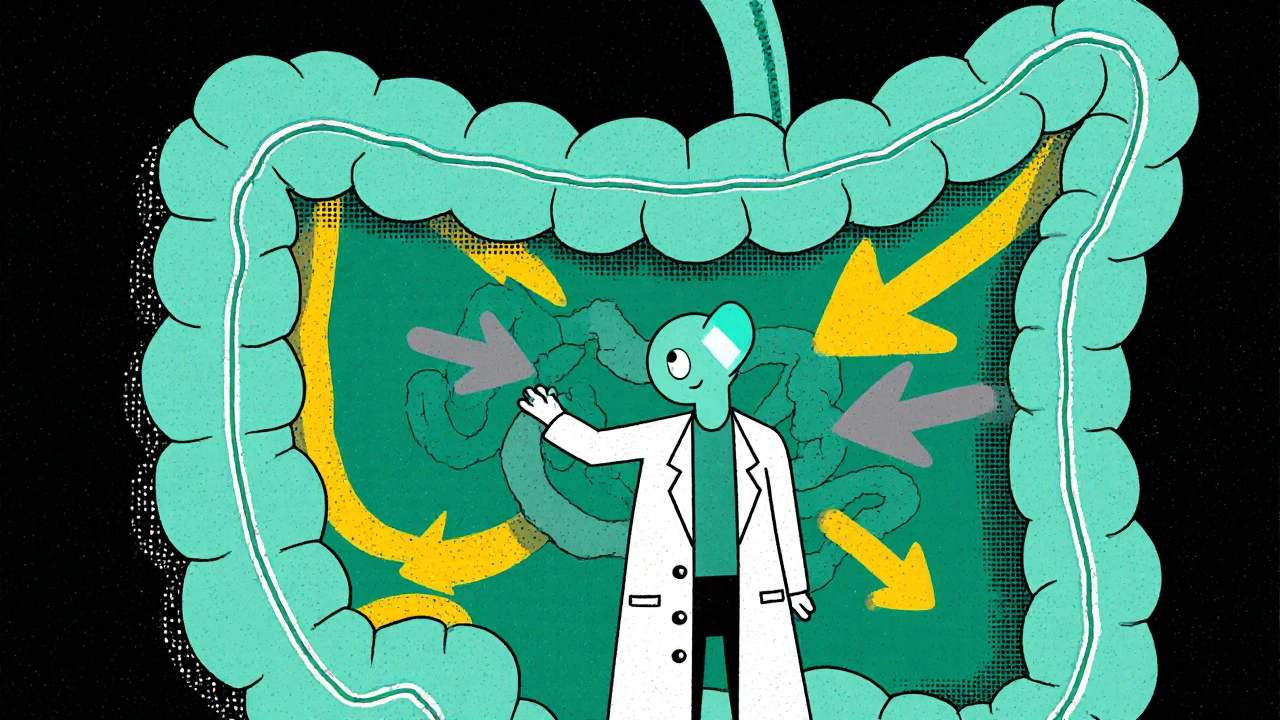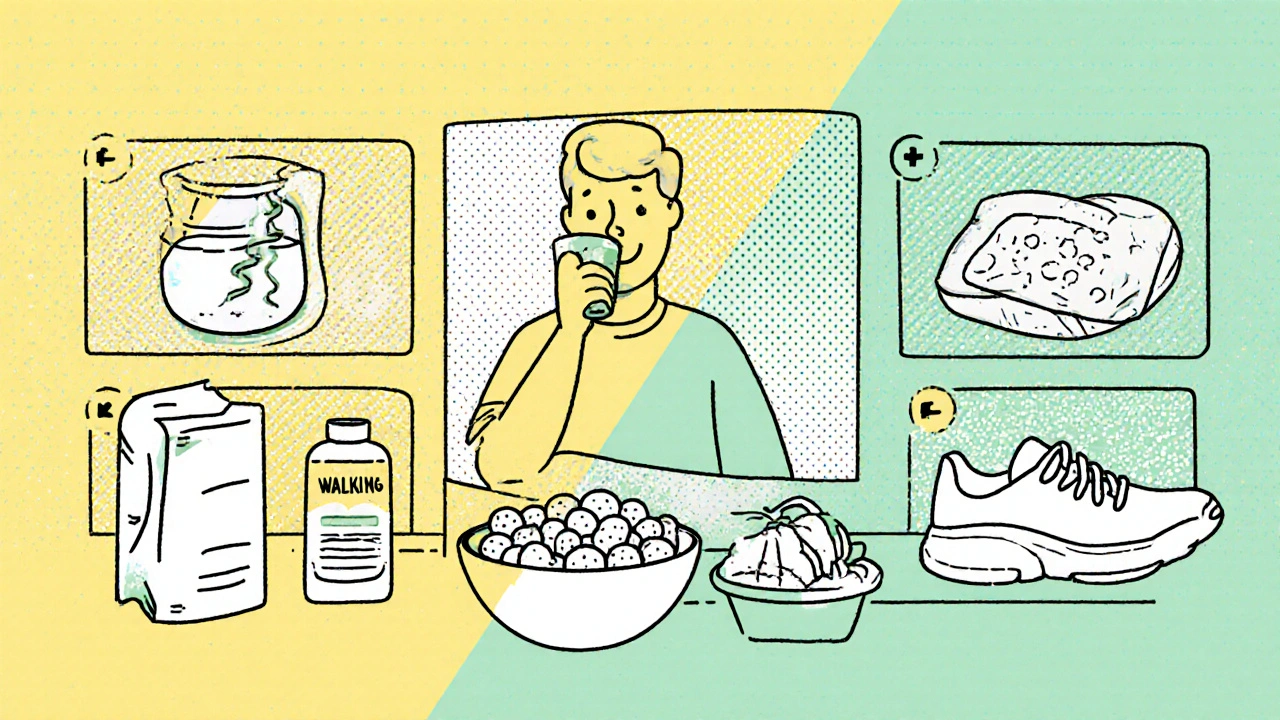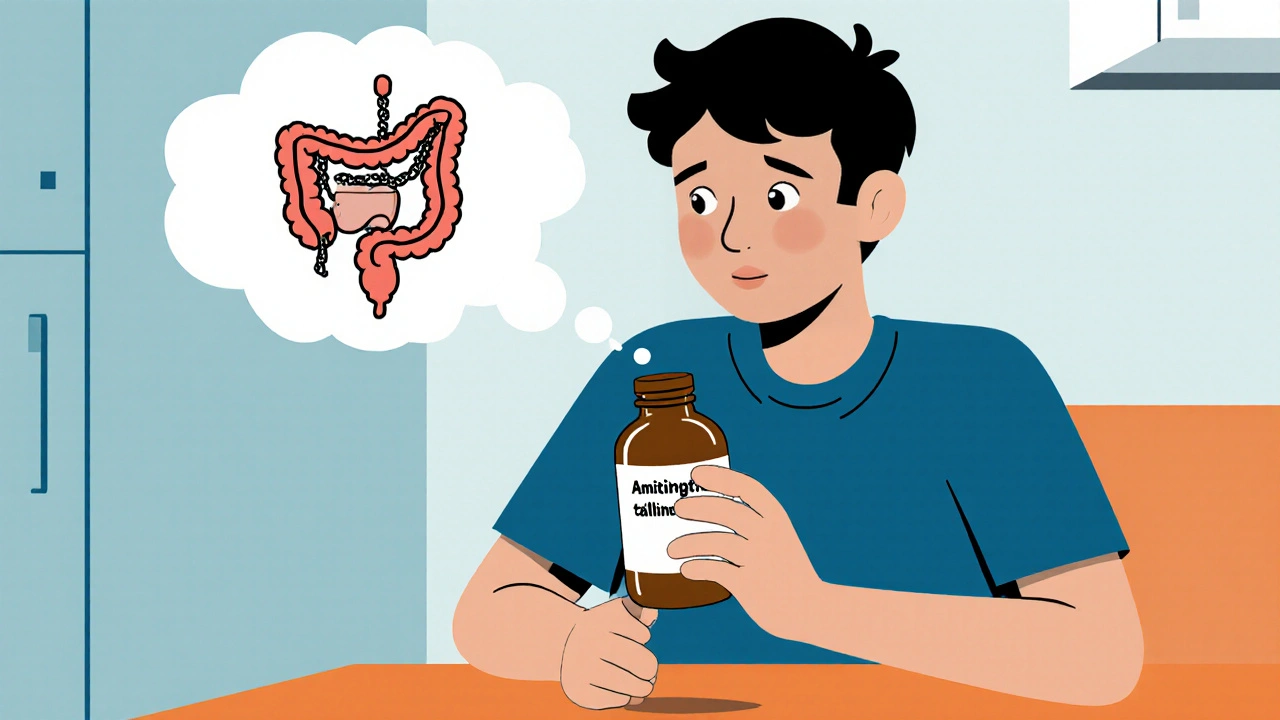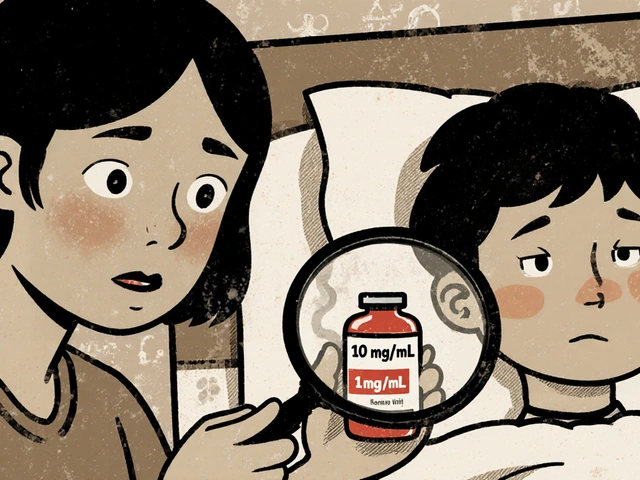Amitriptyline and Constipation: Causes, Risks, and How to Manage Them
Amitriptyline Constipation Risk Calculator
Personal Risk Assessment
This tool calculates your risk of developing constipation while taking amitriptyline based on factors mentioned in the article.
When you’re prescribed amitriptyline is a tricyclic antidepressant that’s often used for depression, chronic pain, and migraines. It works well for many people, but a frequent complaint that slips under the radar is constipation. If you’ve ever wondered why a mood‑lifting pill can stall your bowels, this guide breaks down the science, tells you who’s most vulnerable, and offers practical steps to keep things moving.
How Amitriptyline Works in the Body
Amitriptyline belongs to the tricyclic antidepressant (TCA) family. Its primary job is to boost serotonin and norepinephrine levels by blocking their reuptake in the brain. Higher levels of these neurotransmitters lift mood and can dull nerve‑pain signals. The drug also has a strong anticholinergic effect, meaning it interferes with acetylcholine, a messenger that keeps the gut’s smooth muscles contracting.
Why the Anticholinergic Effect Leads to Constipation
The gastrointestinal (GI) tract relies on a well‑coordinated rhythm called peristalsis. Acetylcholine is a key driver of this rhythm-when it signals the muscle layers, they squeeze and push contents forward. By dampening acetylcholine signaling, amitriptyline slows the wave, reduces the frequency of contractions, and ultimately lets stool sit longer in the colon. The longer stool stays, the more water gets absorbed, turning it hard and difficult to pass.
Who Is Most Susceptible?
- Older adults: Age‑related decline in gut motility combines with the drug’s anticholinergic load, making constipation common in seniors.
- People with a history of bowel issues: Those who already struggle with irritable bowel syndrome (IBS) or chronic constipation are at higher risk.
- Patients on multiple anticholinergic meds: Combining amitriptyline with antihistamines, some antipsychotics, or muscle relaxants can amplify the effect.
- Low‑fluid, low‑fiber diets: Without enough water and fiber, the slowed transit becomes a recipe for hard stools.
Understanding your personal risk profile helps you anticipate the problem before it becomes uncomfortable.

Spotting the Early Signs
Constipation often creeps in quietly. Look for these clues within the first few weeks of starting the medication:
- Fewer than three bowel movements a week.
- Hard, lumpy stools that require straining.
- Abdominal bloating or a feeling of incomplete emptying.
- Lower‑back or pelvic discomfort after meals.
If you notice any of these, don’t ignore them. Early intervention can prevent a cycle of worsening symptoms.
Managing Constipation Without Stopping the Drug
Most clinicians will encourage you to try lifestyle tweaks before adjusting the dose. Below are evidence‑backed strategies that work for the majority of patients.
1. Hydration is Non‑Negotiable
Aim for at least 2 liters (about eight glasses) of water daily. Warm liquids in the morning can jump‑start peristalsis. Avoid excessive caffeine or alcohol, which can dehydrate you.
2. Boost Dietary Fiber
Fiber adds bulk and draws water into the stool. Target 25-30 grams per day from sources like:
- Whole grains (oats, bran, whole‑wheat bread)
- Legumes (lentils, chickpeas, beans)
- Fruits with skins (apples, pears, berries)
- Vegetables (broccoli, carrots, leafy greens)
Introduce fiber gradually to avoid gas.
3. Move Your Body
Even a brisk 20‑minute walk after meals stimulates the colon. Light resistance training 2-3 times a week improves overall muscle tone, including the gut’s smooth muscle.
4. Consider Over‑The‑Counter Laxatives
When diet and exercise fall short, a short‑term laxative can provide relief. Choose based on your comfort level:
| Remedy | Type | Typical Onset | Pros | Cons |
|---|---|---|---|---|
| Bulk‑forming agents | Fiber supplement | 12‑24 hrs | Natural, safe for long‑term | May cause bloating if rushed |
| Osmotic laxatives (e.g., polyethylene glycol) | Osmotic | 6‑12 hrs | Effective, gentle on colon | Need plenty of water |
| Stimulant laxatives (e.g., bisacodyl) | Stimulant | 30‑60 mins | Fast relief | Can cause cramping, not for chronic use |
| Saline laxatives (e.g., magnesium citrate) | Saline | 15‑30 mins | Rapid effect | Can cause electrolyte imbalance |
Use these products for a few days at most. If you need them longer than a week, talk to your doctor.
5. Review Your Medication Dose
Sometimes a modest dose reduction eases the anticholinergic burden without sacrificing therapeutic benefit. Never adjust on your own-discuss any changes with the prescriber.
When to Call Your Healthcare Provider
Persistent constipation (over 2 weeks), severe abdominal pain, blood in stool, or sudden weight loss are red‑flag signs that require medical attention. Your clinician might:
- Switch you to another antidepressant with a lower anticholinergic score, such as an SSRI like sertraline.
- Prescribe a prescription‑strength laxative or a pro‑kinetic agent (e.g., prucalopride).
- Order labs to rule out thyroid issues or metabolic disorders that can mimic drug‑induced constipation.

Alternative Antidepressants With Fewer GI Side Effects
If constipation becomes a chronic nuisance, consider these options after a thorough discussion with your psychiatrist:
- SSRIs (Selective Serotonin Reuptake Inhibitors): Fluoxetine, sertraline, and escitalopram have minimal anticholinergic activity.
- SNRIs (Serotonin‑Norepinephrine Reuptake Inhibitors): Venlafaxine and duloxetine can be effective for pain while sparing the gut.
- Novel agents: Vortioxetine and vilazodone show promising mood benefits with low constipation risk.
Switching drugs is a personal decision that balances mood control, pain relief, and side‑effect tolerance.
Quick Reference Checklist
- Track bowel movements for the first month on amitriptyline.
- Drink ≥ 2 L of water daily.
- Consume 25‑30 g of fiber from whole foods.
- Walk 20 minutes after meals.
- Have a 3‑day supply of an osmotic laxative ready.
- Schedule a follow‑up appointment in 4‑6 weeks to review side effects.
Frequently Asked Questions
Can amitriptyline cause diarrhea instead of constipation?
It’s rare, but in a small subset of people the drug’s effect on serotonin can speed up GI transit, leading to loose stools. If this happens, discuss dose adjustment with your prescriber.
Is it safe to use fiber supplements while on amitriptyline?
Yes. Soluble fiber powders (psyllium) are generally well tolerated and can counteract the anticholinergic slowdown. Just increase fluid intake alongside.
How long does it take for constipation to improve after stopping amitriptyline?
Most anticholinergic effects fade within 2‑3 days after the last dose, but bowel habits may need an extra week of fiber and hydration to normalize fully.
Are there any natural remedies that counteract the anticholinergic effect?
Probiotic‑rich foods (yogurt, kefir, fermented veggies) can improve gut motility, and magnesium‑rich foods (nuts, seeds, leafy greens) support muscle relaxation in the colon.
Should I stop amitriptyline if constipation becomes severe?
Don’t stop abruptly-tapering is essential to avoid withdrawal. Contact your doctor to discuss dose reduction or switching to an alternative medication.






12 Comments
Drew Waggoner
October 18 2025I've been on amitriptyline for months and the constipation never quits. The fiber suggestions help a little but the drug just drags my gut down. I feel like I'm constantly battling a rock in my stomach. Honestly, it's draining my patience.
Mike Hamilton
October 22 2025i read the article and it make sense but i think you need more water
also more fiber is key i have tried oat bran and got better
just drink a couple of liters each day and keep a steady walk routine
keep it simple
Alex Lineses
October 25 2025From a therapeutic standpoint, the anticholinergic load of amitriptyline directly attenuates colonic peristalsis, so augmenting bulk-forming agents is a logical countermeasure. Incorporating soluble fiber such as psyllium while maintaining adequate hydration can mitigate the osmotic imbalance created by reduced acetylcholine signaling. Additionally, scheduled aerobic activity post‑prandial stimulates the enteric nervous system, enhancing motility. For patients on polypharmacy, reviewing concomitant anticholinergic agents can lower the cumulative burden. Finally, a short course of an osmotic laxative like PEG 3350 provides a bridge while dietary adaptations take effect.
Norman Adams
October 28 2025Oh brilliant, another checklist of “just drink more water” and “walk after meals”. As if the pharmacodynamics of a TCA could be outrun by a leisurely stroll. Your jargon won't make the colon care about your elitist advice. Maybe try a placebo next time.
Margaret pope
October 30 2025Water and walk help alot
Karla Johnson
November 4 2025When I first started amitriptyline for chronic migraine, the constipation hit me like a freight train and I wasn’t prepared for how disruptive it would be. I thought the fiber supplement would be enough, but my stools remained hard and passage felt like a struggle against stone. I began tracking every bowel movement, noting the time of day, consistency, and any associated abdominal discomfort. Within a week I realized that my water intake, although meeting the recommended two liters, was spread thinly across the day, which didn’t help the colon retain moisture. I switched to drinking a large glass of warm water first thing each morning, which seemed to cue peristalsis more effectively. Then I introduced a gradual increase in soluble fiber, starting with a tablespoon of psyllium before breakfast, and I made sure to follow it with at least 500 ml of water to avoid bloating. The next change was a consistent post‑meal walk of 20 minutes; I set a timer on my phone to ensure I didn’t skip it on busy days. By the third week I noticed the frequency rising to four movements a week, and the stool texture softened noticeably. I also consulted my physician about a temporary low‑dose osmotic laxative, which we used for ten days to break the initial inertia. The doctor emphasized that any long‑term laxative use should be avoided, and we agreed on a tapering schedule. To complement these steps, I added a probiotic capsule each night, aiming to rebalance the gut microbiota that had been unsettled by the medication. I also incorporated magnesium‑rich foods like almonds and spinach, which seemed to relax the smooth muscle tone of the colon. Over the course of two months the regimen stabilized, and I could resume my usual diet without fearing a bowel emergency. The key takeaway for me was that managing drug‑induced constipation requires a multi‑pronged approach rather than a single fix. Consistency, patience, and communication with your healthcare provider made the difference between chronic discomfort and a manageable side effect.
Linda A
November 6 2025Your detailed chronicle reads like a saga of perseverance, and I appreciate the thoroughness. While the stepwise fiber increase is sound, remember that sudden boosts can cause gas, which many find embarrassing. The probiotic suggestion is a nice touch, though clinical evidence is modest. Keep the tone calm, as over‑dramatic language can distract from the practical advice. Your experience will resonate with many who feel stuck.
Joe Moore
November 10 2025They dont want u to know that the pharma companies rig the data on amitriptyline so u think it's just a simple side effect. Every time i read an article they leave out how the drug messes with the gut nervous system on purpose. It feels like a hidden agenda to keep us dependent on more meds. Stay vigilant and question the sources, cuz they hide the real risks.
James Mali
November 11 2025Well that’s a stretch, but sometimes the hype is overblown. A few practical tips are enough without the drama. Look at the guidelines first.
Janet Morales
November 15 2025I have to say, the whole “just drink water and fiber” narrative is a bit naive. Real life isn’t that tidy, and the drug’s anticholinergic punch can be brutal regardless of diet. You can pour gallons of water and still feel like you’re dragging a sack of rocks. The article glosses over the fact that some patients need prescription‑strength pro‑kinetics. So take the advice with a grain of salt and push your doctor for alternatives.
Tracy O'Keeffe
November 17 2025Oh, dear, you’ve captured the melodrama of the modern sufferer with such panache! Yet, let’s not dismiss the proven efficacy of lifestyle modulation; it’s not merely a “grain of salt” but a cornerstone of holistic care. The pharmacologic nuance of amitriptyline’s anticholinergic index is a subtle symphony, not a blunt hammer. While I revel in the vivid tapestry of your prose, I advocate for a balanced regimen that marries diet, movement, and, when warranted, a judiciously chosen laxative. In short, the solution is a kaleidoscope, not a monolithic edict.
Rajesh Singh
November 20 2025From an ethical standpoint, prescribing a medication with such a high anticholinergic burden without thorough counseling borders on negligence. Physicians have a duty to discuss not only the benefits but also the tangible risks like severe constipation. Patients must be empowered with clear, actionable steps rather than vague admonitions. Moreover, we should prioritize drugs with a cleaner side‑effect profile when possible. The medical community owes us transparency and responsibility.